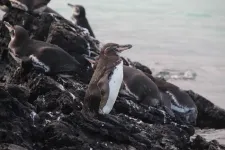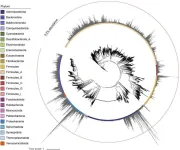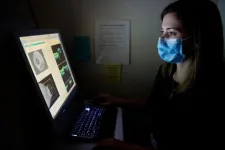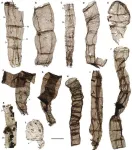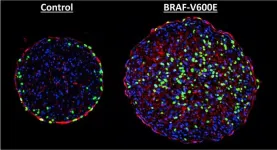(Press-News.org) Modelling shows how microplastics may bioaccumulate in the Galápagos Islands food web, with Galápagos penguins most affected, according to a study published January 24, 2024 in the open-access journal PLOS ONE by Karly McMullen from the University of British Columbia, Canada, under the supervision of Dr. Juan José Alava and Dr. Evgeny A. Pakhomov of the Institute for the Ocean and Fisheries, University of British Columbia, Canada, and colleagues.
We know that microplastics are building up in our oceans, but the extent of the damage to marine organisms is still being assessed. Here, McMullen and colleagues focused on the endangered Galápagos penguin (Spheniscus mendiculus) as an indicator species to trace microplastic bioaccumulation and potential biomagnification (a common concept in ecology describing how toxic pollutants further concentrate and amplify with each trophic level of the food web as predators consume prey) through the unique, fairly simple, and isolated Galápagos Islands food web from the Galápagos Marine Reserve.
To simulate microplastic movement through the Galápagos penguin food web, the authors used data collected in October 2021 from seawater around Santa Cruz Island, a human-populated island with urbanized and rural environments, and some islands harboring penguin colonies, zooplankton, penguin prey (barracuda, sardine, herring, salema and anchovy), and penguin scat to feed two models. They built a model focusing specifically on the Galápagos penguin and its diet and leveraged an existing model of the wider Bolivar Channel Ecosystem (located between Fernandina and Isabela islands), of which the Galápagos islands are a part.
Both models showed a rapid increase in microplastic accumulation and contamination across organisms until around year five of the organism’s life, at which point the rate of uptake shifted to a gradual increase and eventual plateau. The Galápagos penguin showed the highest level of microplastics per biomass, followed by barracuda, anchovy, sardine, herring, and salema and predatory zooplankton (in the ecosystem model, predatory zooplankton showed higher concentrations of microplastics than salema). The ecosystem model also predicted biomagnification of microplastics across all predator-prey relationships, with organisms’ rate of excretion the factor most meaningful in affecting the net accumulation rate.
Though whether microplastics truly bioaccumulate within food webs is still under debate, with much more field research required, the authors note that their study points to the excretion/elimination rate as a key to focus on in future work.
Karly McMullen adds: “The model predictions highlight a key knowledge gap in microplastics science, specifically the accumulation behavior and residence time of microplastics in the gut. With microplastics emerging as a prominent ocean pollutant, entering the environment every day, there is a growing concern for marine fauna and coastal wildlife. To understand microplastics' effects on wildlife and food webs, future research must address how these diverse plastics behave after ingestion.”
Hernán Vargas adds: “The finding of microplastics in the Galápagos penguin, fish prey, and plankton that form part of its food web is undoubtedly worrisome because it shows the globalization of this emerging anthropogenic threat for the conservation of the Galápagos, proving that microplastics can reach isolated and protected areas, such as The Galápagos Archipelago, across thousands of kilometers. Plastic pollution may also affect the public health of human residents inhabiting the islands. As a global threat to ecosystems, global remedies are required to solve it.”
Paola Calle adds: “Having demonstrated the potential bioaccumulation and biomagnification of microplastics in the Galápagos penguin food web alerts us to the potential that these microparticles have on entering and potentially exert adverse effects on the endemic and unique biota of the Galápagos. Therefore, we must raise awareness, actions and public policies that allow us to protect and conserve the endemic and native fauna of the islands.”
J.J. Alava adds: "The ultimate goal of this food web bioaccumulation modeling work is to provide science and data to support risk management of hazardous plastic waste, reduce microplastic emissions in the oceans and marine remote UNESCO Heritage sites such as the Galapagos Islands, and inform local and international marine policy to conserve endangered, endemic seabirds species of Galapagos Marine Reserve."
#####
In your coverage please use this URL to provide access to the freely available article in PLOS ONE: https://journals.plos.org/plosone/article?id=10.1371/journal.pone.0296788
Citation: McMullen K, Vargas FH, Calle P, Alavarado-Cadena O, Pakhomov E, Alava JJ (2024) Modelling microplastic bioaccumulation and biomagnification potential in the Galápagos penguin ecosystem using Ecopath and Ecosim (EwE) with Ecotracer. PLoS ONE 19(1): e0296788. https://doi.org/10.1371/journal.pone.0296788
Author Countries: Canada, Ecuador
Funding: This research was partially funded by the Nippon Foundation via the Nippon Foundation Marine Litter Project at the Institute for the Oceans and Fisheries, University of British Columbia, awarded to J. J. Alava and E. A. Pakhomov under award number F19-02677 (NIPPFOUN 2019) in collaboration with and via the Nippon Foundation-Ocean Nexus Center (Dr. Yoshitaka Ota) at University of Washington [https://oceannexus.uw.edu/about/]. This research was partially supported by the NSERC Discovery Grant RGPIN-2014-05107 to E. A. Pakhomov [https://www.nserccrsng.gc.ca/professors-professeurs/grants-subs/dgigp-psigp_eng.asp]. Both the Nippon Foundation and NSERC funders had no involvement in the study design, data collection and analysis, decision to publish, or preparation of the manuscript.
END
Galápagos penguin is exposed to and may accumulate microplastics at high rate within its food web, modelling suggests
And excretion rate may determine whether or not these microplastics also bioaccumulate across trophic levels
2024-01-24
ELSE PRESS RELEASES FROM THIS DATE:
Obesity spiked in children during COVID-19 lockdowns—only the youngest bounced back
2024-01-24
Obesity among primary school children in the UK spiked during the COVID-19 lockdown, with a 45% increase between 2019/20 and 2020/21 among 4-5-year-olds, according to a study published on January 24, 2024 in the open-access journal PLOS ONE by Iván Ochoa-Moreno from the University of Southampton, UK, and colleagues. The authors estimated that without reversals, increased obesity rates in Year 6 children alone will cost society an additional £800 million in healthcare.
During the first year of the pandemic, school closures dramatically altered the routines of young children. Cancellation of organized sports, ...
Risk of death during heatwaves in Brazil linked to socioeconomic factors
2024-01-24
A new study suggests that heatwaves are exacerbating socioeconomic inequalities in Brazil, with people who are female, elderly, Black, Brown, or who have lower educational levels potentially facing greater risk of death during heatwaves. Djacinto Monteiro dos Santos of Universidade Federal do Rio de Janeiro, Brazil, and colleagues present these findings in the open-access journal PLOS ONE on January 24, 2024.
As climate change progresses, heatwaves are becoming hotter, longer, and more frequent in many regions ...
DNA from preserved feces reveals ancient Japanese gut environment
2024-01-24
DNA from ancient feces can offer archaeologists new clues about the life and health of Japanese people who lived thousands of years ago, according to a study published January 24, 2024 in the open-access journal PLOS ONE by Luca Nishimura and Ituro Inoue from the National Institute of Genetics, Japan, Hiroki Oota from The University of Tokyo, Mayumi Ajimoto from Wakasa History Museum, and colleagues.
Fossilized feces, also known as coprolites, can preserve an array of genetic material from the digestive tracts ...
A virus that infected the first animals hundreds of millions of years ago has become essential for the development of the embryo
2024-01-24
At least 8% of the human genome is genetic material from viruses. It was considered ‘junk DNA’ until recently, but its role in human development is now known to be essential
Researchers at the Spanish National Cancer Research Centre (CNIO) describe for the first time the role of these viruses in a key process in development, when cells become pluripotent few hours after fertilization
The finding, published in Science Advances, is relevant for regenerative medicine and for the creation of artificial ...
City of Hope, TGen researchers develop machine-learning tool to detect cancer earlier via liquid biopsy
2024-01-24
LOS ANGELES — Researchers at City of Hope, one of the largest cancer research and treatment organizations in the United States, and Translational Genomics Research Institute (TGen), a precision medicine research organization that is part of City of Hope, have developed and tested an innovative machine-learning approach that could one day enable the earlier detection of cancer in patients by using smaller blood draws. The study was published today in the journal Science Translational Medicine.
“A huge body of evidence shows that cancer caught at later stages kills people. This new technology gets us closer to a world ...
Gene behind heart defects in Down syndrome identified
2024-01-24
Francis Crick Institute press release
Under strict embargo: 19:00hrs GMT 24 January 2024
Peer reviewed
Experimental study
Animals
Gene behind heart defects in Down syndrome identified
Researchers at the Francis Crick Institute and UCL have identified a gene that causes heart defects in Down syndrome, a condition that results from an additional copy of chromosome 21.
Reducing the overactivity of this gene partially reversed these defects in mice, setting the scene for potential future therapies for heart conditions in people with Down syndrome.
Down syndrome ...
Moving humanoid robots outside research labs: the evolution of the iCub3 avatar system
2024-01-24
Genova (Italy), 24 January 2024 - Over the past four years, the research team at the Artificial and Mechanical Intelligence (AMI) lab at the Istituto Italiano di Tecnologia (IIT-Italian Institute of Technology) in Genova (Italy) has developed advanced avatar technologies, known as the iCub3 system, in continuous testing with real-world scenarios. The system was utilized to enable a human operator to remotely visit locations 300 km away, to entertain the public at events and television appearances, and ...
Retinal imaging and genetics data used to predict future disease risk
2024-01-24
Mass Eye and Ear physician-researchers show that retinal imaging can help predict a person’s risk of developing ocular, neuropsychiatric, cardiac, metabolic, and pulmonary diseases.
The team also identified genetic loci associated with retinal thinning, which could help develop personalized treatment plans and future therapies for eye diseases such as glaucoma and macular degeneration.
The retina is said to provide a window into a person’s systemic health. In a new study published January 24th in Science Translational Medicine, physician-researchers from Mass ...
North China fossils show eukaryotes first acquired multicellularity 1.63 billion years ago
2024-01-24
In a study published in Science Advances on Jan. 24, researchers led by Prof. ZHU Maoyan from the Nanjing Institute of Geology and Palaeontology of the Chinese Academy of Sciences reported their recent discovery of 1.63-billion-year-old multicellular fossils from North China.
These exquisitely preserved microfossils are currently considered the oldest record of multicellular eukaryotes. This study is another breakthrough after the researchers’ earlier discovery of decimeter-sized eukaryotic fossils in the Yanshan area ...
Harnessing skin cancer genes to heal hearts
2024-01-24
DURHAM, N.C. – Biomedical engineers at Duke University have demonstrated that one of the most dangerous mutations found in skin cancers might moonlight as a pathway to mending a broken heart.
The genetic mutation in the protein BRAF, a part of the MAPK signaling pathway that can promote cell division, is one of the most common and most aggressive found in melanoma patients. In a new study, researchers show that introducing this mutation to rat heart tissue grown in a laboratory can induce growth.
Repairing ...
LAST 30 PRESS RELEASES:
University of Oklahoma researcher awarded funding to pursue AI-powered material design
Exploring how the visual system recovers following injury
Support for parents with infants at pediatric check-ups leads to better reading and math skills in elementary school
Kids’ behavioral health is a growing share of family health costs
Day & night: Cancer disrupts the brain’s natural rhythm
COVID-19 vaccination significantly reduces risk to pregnant women and baby
The role of vaccination in maternal and perinatal outcomes associated with COVID-19 in pregnancy
Mayo Clinic smartwatch system helps parents shorten and defuse children's severe tantrums early
Behavioral health spending spikes to 40% of all children’s health expenditures, nearly doubling in a decade
Digital cognitive behavioral treatment for generalized anxiety disorder
Expenditures for pediatric behavioral health care over time and estimated family financial burden
Air conditioning in nursing homes and mortality during extreme heat
The Alps to lose a record number of glaciers in the next decade
What makes a good proton conductor?
New science reporting guide published for journalists in Bulgaria
New international study reveals major survival gaps among children with cancer
New science reporting guide published for journalists in Turkey
Scientists develop a smarter mRNA therapy that knows which cells to target
Neuroanatomy-informed brain–machine hybrid intelligence for robust acoustic target detection
Eight SwRI hydrogen projects funded by ENERGYWERX
The Lundquist Institute and its start-up company Vitalex Biosciences Announces Strategic Advancement of Second-Generation fungal Vaccine VXV-01 through Phase 1 Trials under $40 Million Competitive Con
Fine particles in pollution are associated with early signs of autoimmune disease
Review article | Towards a Global Ground-Based Earth Observatory (GGBEO): Leveraging existing systems and networks
Penn and UMich create world’s smallest programmable, autonomous robots
Cleveland researchers launch first major study to address ‘hidden performance killer’ in athletes
To connect across politics, try saying what you oppose
Modulating key interaction prevents virus from entering cells
Project explores barriers to NHS career progression facing international medical graduates
Jeonbuk National University researchers explore the impact of different seasonings on the flavor perception of Doenjang soup
Two Keck Medicine of USC Hospitals named Leapfrog Top Teaching Hospitals
[Press-News.org] Galápagos penguin is exposed to and may accumulate microplastics at high rate within its food web, modelling suggestsAnd excretion rate may determine whether or not these microplastics also bioaccumulate across trophic levels
